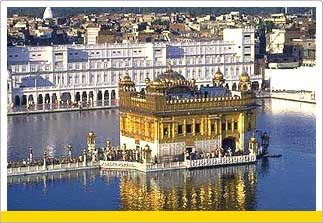Punjabi blues
Amritsar, Punjab Pradesh, India
At first glance, the Punjabi spiritual capital of Amritsar, close to the Pakistan border, is a dirty, hot, noisy, sweltering disaster area. But this is inaccurate, as you peer deeper into its interior, one discovers that it is a really, really, really hot, noisy, dirty sweltering disaster area. It's one saving grace however, aside from fairly friendly natives, is the famed Golden Temple of Amritsar,

which does make it worth it -- barely.

which does make it worth it -- barely.
The Golden Temple is the vatican/mecca/wailing wall/jokhang of the Sikh faith. While the Sikhs have a well earned reputation of being sort of warlike and martial (It is guarded by spear carrying sikhs, plus I saw a guy carrying around an actual medieval flail in the temple), Sikhism itself is a pretty interesting religion. It comes from the Indo/Pak border areas It's described as a blend of hinduism & islam, though I don't know if that's very accurate. It's more of a reaction to both. It's actually based on very egalitarian and democratic principles, renouncing the caste system of any kind (that's why all Sikh men take the name Singh (lion) and woment take the name Kaur (wolf or something, I forget) and welcoming to people of all faiths. In fact in the Golden Temple, all are welcome to get a free communal meal in the Langor with the Sikhs regardless of race, creed, color, religion. In what I think must be a subconscious jab at Islam, in sikhism both men and women are required to cover their hair and carry daggers.
Speaking of the daggers, the warlike tradition of the Sikhs contrasts a bit with the religion, although since they were the barrier against Islam on the west and later the guardians of the British frontier its only natural. The British themselves waited till a period of Sikh infighting to conquer them, not wanting to take on the whole nation. Afterwards, and up to this day, they formed the backbone of the Indian army, and still do, despite the troubles in 1984 that led to Indira Gandhi's demise. A placard in the Sikh museum next to a picture of the destroyed facade of the temple gleefully alludes to the Sikh revenge against Indira. The rest of the museum features, among various guru portraits and battle scenes, oil paintings of Sikh martyrs being: mutilated, boiled, crushed by giant wheels, sawed in half vertically, and otherwise disembowled. But they're actually a fairly nice lot, the Sikhs, everybody at the temple seemed happy to see me otherwise.
On the 5-hour way here yesterday I took a bone-rattling, dirt cheap state bus. It was , crowded, uncomfortable, and hot (but I don't think anybody vomited) but actually in a sick way I sort of enjoyed it. Taking that mode of transport is a good way to go local, if miserably, and gives you a glimpse as to what life is like for 15-=20% of the world's populace. So think of me as a man of the people, like Gandhi, except with a platinum card.


0 Comments:
Post a Comment
<< Home